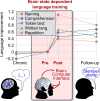Aphasia recovery by language training using a brain-computer interface: a proof-of-concept study
- PMID: 35178518
- PMCID: PMC8846581
- DOI: 10.1093/braincomms/fcac008
Aphasia recovery by language training using a brain-computer interface: a proof-of-concept study
Abstract
Aphasia, the impairment to understand or produce language, is a frequent disorder after stroke with devastating effects. Conventional speech and language therapy include each formal intervention for improving language and communication abilities. In the chronic stage after stroke, it is effective compared with no treatment, but its effect size is small. We present a new language training approach for the rehabilitation of patients with aphasia based on a brain-computer interface system. The approach exploits its capacity to provide feedback time-locked to a brain state. Thus, it implements the idea that reinforcing an appropriate language processing strategy may induce beneficial brain plasticity. In our approach, patients perform a simple auditory target word detection task whilst their EEG was recorded. The constant decoding of these signals by machine learning models generates an individual and immediate brain-state-dependent feedback. It indicates to patients how well they accomplish the task during a training session, even if they are unable to speak. Results obtained from a proof-of-concept study with 10 stroke patients with mild to severe chronic aphasia (age range: 38-76 years) are remarkable. First, we found that the high-intensity training (30 h, 4 days per week) was feasible, despite a high-word presentation speed and unfavourable stroke-induced EEG signal characteristics. Second, the training induced a sustained recovery of aphasia, which generalized to multiple language aspects beyond the trained task. Specifically, all tested language assessments (Aachen Aphasia Test, Snodgrass & Vanderwart, Communicative Activity Log) showed significant medium to large improvements between pre- and post-training, with a standardized mean difference of 0.63 obtained for the Aachen Aphasia Test, and five patients categorized as non-aphasic at post-training assessment. Third, our data show that these language improvements were accompanied neither by significant changes in attention skills nor non-linguistic skills. Investigating possible modes of action of this brain-computer interface-based language training, neuroimaging data (EEG and resting-state functional MRI) indicates a training-induced faster word processing, a strengthened language network and a rebalancing between the language- and default mode networks.
Keywords: aphasia rehabilitation; brain–computer interface; chronic stroke; language training; neurofeedback training.
© The Author(s) 2022. Published by Oxford University Press on behalf of the Guarantors of Brain.
Figures






Similar articles
-
FCET2EC (From controlled experimental trial to = 2 everyday communication): How effective is intensive integrative therapy for stroke-induced chronic aphasia under routine clinical conditions? A study protocol for a randomized controlled trial.Trials. 2013 Sep 23;14:308. doi: 10.1186/1745-6215-14-308. Trials. 2013. PMID: 24059983 Free PMC article. Clinical Trial.
-
Influence of pitch modulation on event-related potentials elicited by Dutch word stimuli in a brain-computer interface language rehabilitation task.J Neural Eng. 2025 May 9;22(3). doi: 10.1088/1741-2552/adc83d. J Neural Eng. 2025. PMID: 40174604
-
Effects of computer-based therapy versus therapist-mediated therapy in stroke-related aphasia: Pilot non-inferiority study.J Commun Disord. 2021 Nov-Dec;94:106158. doi: 10.1016/j.jcomdis.2021.106158. Epub 2021 Oct 8. J Commun Disord. 2021. PMID: 34673449 Clinical Trial.
-
Post-stroke language disorders.Acta Clin Croat. 2011 Mar;50(1):79-94. Acta Clin Croat. 2011. PMID: 22034787 Review.
-
Advanced magnetic resonance neuroimaging of language function recovery after aphasic stroke: a technical review.Arch Phys Med Rehabil. 2012 Jan;93(1 Suppl):S4-14. doi: 10.1016/j.apmr.2011.02.023. Arch Phys Med Rehabil. 2012. PMID: 22202190 Review.
Cited by
-
Post-stroke aphasia rehabilitation using an adapted visual P300 brain-computer interface training: improvement over time, but specificity remains undetermined.Front Hum Neurosci. 2024 May 30;18:1400336. doi: 10.3389/fnhum.2024.1400336. eCollection 2024. Front Hum Neurosci. 2024. PMID: 38873652 Free PMC article.
-
Digital health technologies and artificial intelligence in cardiovascular clinical trials: A landscape of the European space.Digit Health. 2024 Sep 5;10:20552076241277703. doi: 10.1177/20552076241277703. eCollection 2024 Jan-Dec. Digit Health. 2024. PMID: 39291150 Free PMC article. Review.
-
Efficacy and safety of brain-computer interface for stroke rehabilitation: an overview of systematic review.Front Hum Neurosci. 2025 Mar 6;19:1525293. doi: 10.3389/fnhum.2025.1525293. eCollection 2025. Front Hum Neurosci. 2025. PMID: 40115885 Free PMC article.
-
Towards Predictive Communication: The Fusion of Large Language Models and Brain-Computer Interface.Sensors (Basel). 2025 Jun 26;25(13):3987. doi: 10.3390/s25133987. Sensors (Basel). 2025. PMID: 40648241 Free PMC article. Review.
-
Syntax Acquisition in Healthy Adults and Post-Stroke Individuals: The Intriguing Role of Grammatical Preference, Statistical Learning, and Education.Brain Sci. 2022 May 9;12(5):616. doi: 10.3390/brainsci12050616. Brain Sci. 2022. PMID: 35625003 Free PMC article.
References
-
- Dickey L, Kagan A, Lindsay MP, Fang J, Rowland A, Black S. Incidence and profile of inpatient stroke-induced aphasia in Ontario, Canada. Arch Phys Med Rehabil. 2010;91(2):196–202. - PubMed
-
- Dalemans RJ, De Witte LP, Beurskens AJ, Van Den Heuvel WJ, Wade DT. An investigation into the social participation of stroke survivors with aphasia. Disabil Rehabil. 2010;32(20):1678–1685. - PubMed
-
- Doucet T, Muller F, Verdun-Esquer C, Debelleix X, Brochard P. Returning to work after a stroke: A retrospective study at the Physical and Rehabilitation Medicine Center ‘La Tour de Gassies’. Ann Phys Rehabil Med. 2012;55(2):112–127. - PubMed
-
- Berthier ML. Poststroke aphasia: Epidemiology, pathophysiology and treatment. Drugs Aging. 2005;22(2):163–182. - PubMed
LinkOut - more resources
Full Text Sources
